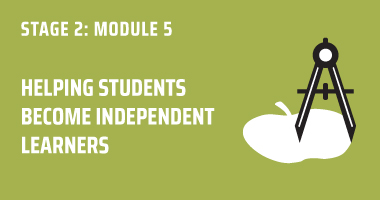Module 5: Helping Students Become Independent Learners
TIMING: You’ll spend a minimum of 3 weeks in this module after completion of Lesson 1. Watch video to end.
By the End of this Module…
You will have a deeper understanding of the CHEW components of the Ready for Rigor Instructional Lesson Design template and its role in helping students become cognitively independent learners.
You will learn the necessary practices to put in place in order to help students “chew” on the content productively so they experience growth in dendrites and neural pathways that build stamina to carry more of the cognitive load over time.
You will learn the basic teacher moves necessary to become a cognitive mediator (personal trainer of student cognition) within the instructional core.
You will learn the steps necessary to dismantle over-scaffolding in order to help students engage in more productive struggle.

LESSONS IN THIS MODULE
OVERVIEW
In Module 4, we reviewed the lesson design template, and we zeroed in on the INPUT (Chunk) and IGNITE sections. Often, this redesign of the content is what is thought to be culturally responsive practice. But we know that just changing the content doesn’t help students who are behind, catch up.
The heart of culturally responsive practice is coaching students to expand their intellectual capacity so that they are doing the “heavy lifting” during a lesson. That means increasing their ability to think deeply, make connections between what they know and the content, through productive struggle, and make meaning of the content so that it’s sticky (i.e., remember it, can apply it in other contexts, and add it permanently to their background knowledge).
In this module we are going to dig deeper into the basics of supporting students to be cognitively independent learners.
Remember, this isn’t about getting them to be “on task” through compliance. It is about using our knowledge of the science of learning to get them to level up their information processing skills so that you can slowly begin to deconstruct any over-scaffolding that you find yourself doing.
An important point to make here. This process takes time. Take a holistic, long-term view. These are only the basics. It is made up of more than one-off strategies. You will have to change your structures, processes, instructional timing, so that you can get students to behave in new ways. But you can’t change everything at once. And the older the students who are dependent learners, the more they will resist.
Stage 2, Modules 4-6, are focused on closing the knowing-doing gap. That means you will have to do something. Where to start? Build on the groundwork we laid in Module 2 and Module 3, with the new talk structures (powerful protocols over weak “turn and talk”) and use of the two cognitive tools — retrieval practice and the muddiest point protocol.
Equity means you are investing time in planning, prototyping new practices, and iterating to improve on their impact.
Save to My Content
